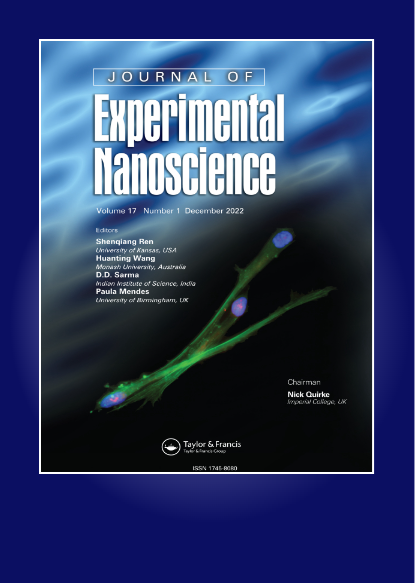A new approach for the management of Escherichia coli and Klebsiella pneumonia by using cefixime-based bionanocomposite films
IF 2.6
4区 材料科学
Q2 CHEMISTRY, MULTIDISCIPLINARY
引用次数: 0
Abstract
Abstract Purpose: The aim of this study was to assess the antibacterial potential and ex vivo skin permeation kinetics of cefixime from bionanocomposite films. Methods: The films were prepared by solvent casting method by using chitosan and starch. The fabricated films were tested for their antibacterial potential against three bacteria i.e. Escherichia coli, Klebsiella pneumonia, and Acetobacter aceti. In vitro permeation studies of cefixime from the films across rat skin was conducted using Franz diffusion cell. Results: The highest antibacterial effect was exhibited by F5 formulation (non-irradiated film) against Escherichia coli and Klebsiella pneumonia; however, antibacterial activity of the films was significantly (p < 0.05) reduced after their irradiation. F5 formulation showed the highest cumulative amount of permeated drug after 24 h, while F1 (100% chitosan) showed the lowest amount of permeated drug. Non-Fickian diffusion (anomalous) was the main mode of drug release from all films. The cross-linking of films by γ-radiations improved their mechanical properties. The percentage swelling ratio was the highest in non-irradiated films having a polymeric blend (50:50). Water uptake of irradiated films was appreciably reduced as compared to non-irradiated films. Conclusion: The synthesized bionanocomposites are promising therapeutic moieties which not only improve drug permeability across but also ameliorates antibacterial potential of cefixime.头孢克肟基生物纳米复合膜治疗大肠杆菌和肺炎克雷伯菌的新方法
摘要目的:本研究旨在评估头孢克肟在生物纳米复合膜中的抗菌潜力和体外皮肤渗透动力学。方法:以壳聚糖和淀粉为原料,采用溶剂浇铸法制备薄膜。测试了所制备的薄膜对三种细菌的抗菌潜力,即大肠杆菌、肺炎克雷伯菌和醋酸杆菌。使用Franz扩散池对头孢克肟从薄膜中穿过大鼠皮肤的体外渗透性进行了研究。结果:F5制剂(非辐照膜)对大肠杆菌和肺炎克雷伯菌的抗菌效果最高;然而,薄膜的抗菌活性显著(p < 0.05)在照射后减少。F5制剂在24小时后显示出最高的渗透药物累积量 h、 而F1(100%壳聚糖)的药物渗透量最低。非菲克扩散(异常)是所有膜释放药物的主要方式。γ辐射交联薄膜改善了薄膜的力学性能。在具有聚合物共混物(50:50)的未辐照膜中,溶胀率百分比最高。与未辐照的薄膜相比,辐照薄膜的吸水率明显降低。结论:合成的仿生纳米复合物是一种很有前景的治疗部分,它不仅改善了药物的渗透性,而且提高了头孢克肟的抗菌潜力。
本文章由计算机程序翻译,如有差异,请以英文原文为准。
求助全文
约1分钟内获得全文
求助全文
来源期刊

Journal of Experimental Nanoscience
工程技术-材料科学:综合
CiteScore
4.10
自引率
25.00%
发文量
39
审稿时长
6.5 months
期刊介绍:
Journal of Experimental Nanoscience, an international and multidisciplinary journal, provides a showcase for advances in the experimental sciences underlying nanotechnology and nanomaterials.
The journal exists to bring together the most significant papers making original contributions to nanoscience in a range of fields including biology and biochemistry, physics, chemistry, chemical, electrical and mechanical engineering, materials, pharmaceuticals and medicine. The aim is to provide a forum in which cross fertilization between application areas, methodologies, disciplines, as well as academic and industrial researchers can take place and new developments can be encouraged.
 求助内容:
求助内容: 应助结果提醒方式:
应助结果提醒方式:


